The bus ride from Rio de Janeiro to Ouro Prêto is…unpleasant. The seats are uncomfortable, there’s no food, and not a steward in sight. All Christi and I have is a very argumentative driver and a long bumpy road. We do, however, arrive on time. I manage some sleep, but Christi does not because her shoulders are painfully sunburned. Quite how she managed this in Rio is beyond me. Unfortunately, we have not escaped the rain and I slosh through puddles lugging both packs (one on my front and the other on my back). Apparently Christi’s sunburn means she can’t carry her pack; how convenient). Fortunately our hostel of choice is near the bus station and it offers fantastic views over Ouro Prêto.
The town, set among magnificent, brooding mountain scenery, is almost a living museum of 18th century life in colonial Brazil. The hilly cobblestone streets are steep and in wet weather (i.e. now) perilously slippery. While much of the gold extracted from Ouro Prêto left the town, enough wealth survived to build a vast array of mostly baroque churches. Churches in Ouro Prêto are as common as village pubs in England. Before embracing so much religious architecture and iconography, however, we’re drawn to a sidewalk café in Tiradentes square where we warm up with a few mugs of delicious hot chocolate.
Much like Potosi in Bolivia, Ouro Prêto owes its very existence to the mining industry (and both towns share a similarly unpalatable record regarding the use of slave labor). It’s also possible to visit a mine in Ouro Prêto, but there’s zero chance of us doing that again.
Ouro Prêto actually means black gold and refers to the fact that huge deposits of oxidized (black) gold were found here in the early 18th century. At the height of the boom, half of the entire world’s gold production originated here, helping to fund the Portuguese empire (and because of its trade links with England, the Industrial Revolution). Local resentment at ever increasing taxes levied by Portugal eventually lead to revolution under the leadership of the poet-dentist Joaquin Jose da Silva Xavier (nicknamed Tiradentes – the tooth-puller). Unfortunately the rebellion (Inconfidencia Mineira) was crushed and Tiradentes publically executed in Rio in quite barbaric fashion. Ironically, he is now revered as one of Brazil’s earliest patriots. These events are recounted at the Museo da Inconfidencia, which we visit first in hopes of avoiding the worst of the ongoing downpour.
The rain hereabouts is nothing if not tenacious, however, and is still happily falling as we lose ourselves among the many baroque churches in Ouro Prêto, beginning with the Matriz de nossa senhora do Pilar, which is the richest, most lavishly decorated church in Ouro Prêto, containing more than 400 kg of gold. Next we visit Igreja nossa senhora das Merces de Cima. The façade of this church is attributed to Aleijadinho, a remarkable sculptor and architect who, as a young man, lost the use of his hands (possibly due to leprosy). However, with a hammer and chisel strapped to his arms he continued carving exquisite pieces and became very successful. The last church we visit (before getting churched out) is the Igreja de Sao Francisco de Paula, which has a great location overlooking the town. It was the last church built during the colonial period.
Blog post by Roderick Phillips, author of Weary Heart – a gut-wrenching, heart-wrenching, laugh-wrenching tale.

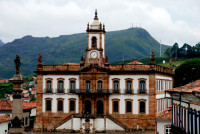
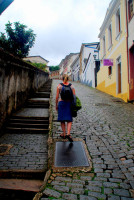
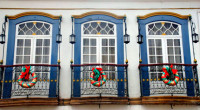
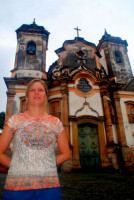
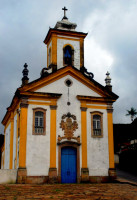
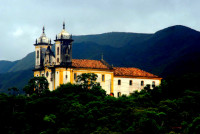
Speak Your Mind